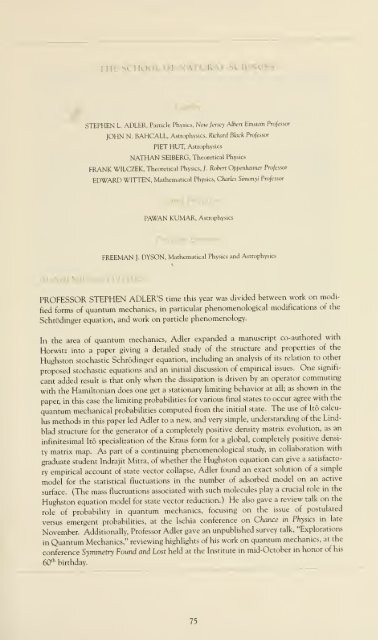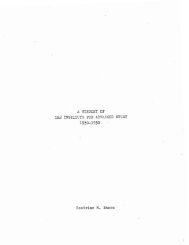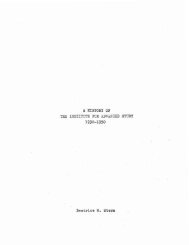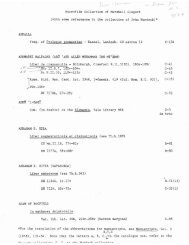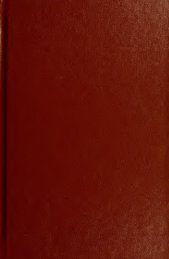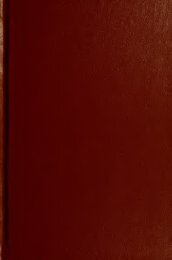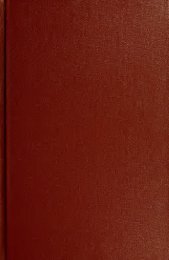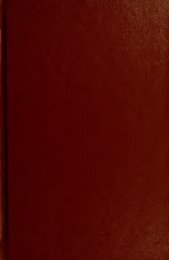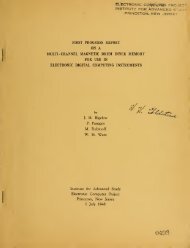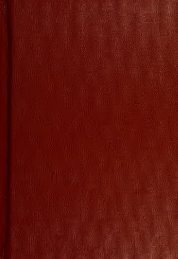Report for the academic year - Libraries - Institute for Advanced Study
Report for the academic year - Libraries - Institute for Advanced Study
Report for the academic year - Libraries - Institute for Advanced Study
You also want an ePaper? Increase the reach of your titles
YUMPU automatically turns print PDFs into web optimized ePapers that Google loves.
SCHOOL •<br />
STEPHEN L. ADLER, Particle Physics, New Jersey Albert Einstein Professor<br />
)OHN N. BAHCALL, Astrophysics, Richard Black Professor<br />
P1ET HUT, Astrophysics<br />
NATHAN SEIBERG, Theoretical Physics<br />
FRANK WILCZEK, Theoretical Physics, J. Robert Oppenheimer Professor<br />
EDWARD W1TTEN, Ma<strong>the</strong>matical Physics, Charles Simonyi Professor<br />
PAWAN KUMAR, Astrophysics<br />
FREEMAN J. DYSON, Ma<strong>the</strong>matical Physics and Astrophysics<br />
PROFESSOR STEPHEN ADLER'S time this <strong>year</strong> was divided between work on modi-<br />
fied <strong>for</strong>ms of quantum mechanics, in particular phenomenological modifications of <strong>the</strong><br />
Schrodinger equation, and work on particle phenomenology.<br />
In <strong>the</strong> area of quantum mechanics, Adler expanded a manuscript co-authored with<br />
Horwitz into a paper giving a detailed study of <strong>the</strong> structure and properties of <strong>the</strong><br />
Hughston stochastic Schrodinger equation, including an analysis of its relation to o<strong>the</strong>r<br />
proposed stochastic equations and an initial discussion of empirical issues. One signifi-<br />
cant added result is that only when <strong>the</strong> dissipation is driven by an operator commuting<br />
with <strong>the</strong> Hamiltonian does one get a stationary limiting behavior at all; as shown in <strong>the</strong><br />
paper, in this case <strong>the</strong> limiting probabilities <strong>for</strong> various final states to occur agree with <strong>the</strong><br />
quantum mechanical probabilities computed from <strong>the</strong> initial state. The use of Ito calcu-<br />
lus methods in this paper led Adler to a new, and very simple, understanding of <strong>the</strong> Lind-<br />
blad structure <strong>for</strong> <strong>the</strong> generator of a completely positive density matrix evolution, as an<br />
infinitesimal Ito specialization of <strong>the</strong> Kraus <strong>for</strong>m <strong>for</strong> a global, completely positive densi-<br />
ty matrix map. As part of a continuing phenomenological study, in collaboration with<br />
graduate student Indrajit Mitra, of whe<strong>the</strong>r <strong>the</strong> Hughston equation can give a satisfacto-<br />
ry empirical account of state vector collapse, Adler found an exact solution of a simple<br />
model <strong>for</strong> <strong>the</strong> statistical fluctuations in <strong>the</strong> number of adsorbed model on an active<br />
surface. (The mass fluctuations associated with such molecules play a crucial role in <strong>the</strong><br />
Hughston equation model <strong>for</strong> state vector reduction.) He also gave a review talk on <strong>the</strong><br />
role of probability in quantum mechanics, focusing on <strong>the</strong> issue of postulated<br />
versus emergent probabilities, at <strong>the</strong> Ischia conference on Chance in Physics in late<br />
November. Additionally, Professor Adler gave an unpublished survey talk, "Explorations<br />
in Quantum Mechanics," reviewing highlights of his work on quantum mechanics, at <strong>the</strong><br />
conference Symmetry Found and Lost held at <strong>the</strong> <strong>Institute</strong> in mid-October in honor ot his<br />
60 th birthday.<br />
75


